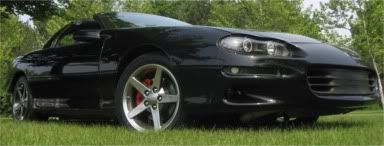Been working on replacing the air box on my 98 Firebird with angled intake manifold.
First thing I did was a simple change to bypass the air box to see what the affect would be. I used simple aluminum coiled dryer hose to connect the filter box to the manifold. This seems to provide good high RPM improvement even with no change to the filter box. But this can't be a permanent change because dryer vent hose just won't hold up long term.

Note how it rubs the radiator housing. Not good.
Next I went looking for some materials that would hold up better than dryer hose. Plain old PVC fittings in 4" were too big, and 3" is too small. I came across a lightweight HDPE collapsible and bendable drain pipe designed for 4" applications. This was cut and fit in place of the dryer vent, but also uses the rubber boot from the air filter box to connect.

This worked much better. Notice this version is also rubbing the radiator, but it is actually much smoother inside than the dryer vent. Also notice how nicely the factory rubber boot transitions from oval on the air filter to round on the flexible hose.
In both tests, tie wraps were used to hold things together because these are only tests.
The plastic hose will be left on for a week or so to see how it holds up to under hood temps. The long term plan is to use the plastic as a mold to pull a fiberglass hose from. Probably wrap the plastic hose with paper mache to make it rigid, and easy to clean up any mess under the hood. Then the paper mache coated hose is removed, smoothed (to get rid of the ribs) and covered in two or three layers of fiberglass. Then its cut in half length wise, the plastic pipe and paper mache removed, and the two halves glassed back together.
If anyone wants to do the plastic pipe route, the pipe is this available at Lowes for about $7.00:

But for long term use, a piece of rubber, like bicycle tube, or another layer of corrigated pipe should be wrapped around the pipe where it rubs the radiator. Another step is to wrap the whole intake with foil backed foam insulation to help keep the incoming air from absorbing heat from under hood.
Well, thats how far I got. Will run the HDPE pipe for a week or so and then proceed to making a fiberglass permanent pipe.
First thing I did was a simple change to bypass the air box to see what the affect would be. I used simple aluminum coiled dryer hose to connect the filter box to the manifold. This seems to provide good high RPM improvement even with no change to the filter box. But this can't be a permanent change because dryer vent hose just won't hold up long term.

Note how it rubs the radiator housing. Not good.
Next I went looking for some materials that would hold up better than dryer hose. Plain old PVC fittings in 4" were too big, and 3" is too small. I came across a lightweight HDPE collapsible and bendable drain pipe designed for 4" applications. This was cut and fit in place of the dryer vent, but also uses the rubber boot from the air filter box to connect.

This worked much better. Notice this version is also rubbing the radiator, but it is actually much smoother inside than the dryer vent. Also notice how nicely the factory rubber boot transitions from oval on the air filter to round on the flexible hose.
In both tests, tie wraps were used to hold things together because these are only tests.
The plastic hose will be left on for a week or so to see how it holds up to under hood temps. The long term plan is to use the plastic as a mold to pull a fiberglass hose from. Probably wrap the plastic hose with paper mache to make it rigid, and easy to clean up any mess under the hood. Then the paper mache coated hose is removed, smoothed (to get rid of the ribs) and covered in two or three layers of fiberglass. Then its cut in half length wise, the plastic pipe and paper mache removed, and the two halves glassed back together.
If anyone wants to do the plastic pipe route, the pipe is this available at Lowes for about $7.00:

But for long term use, a piece of rubber, like bicycle tube, or another layer of corrigated pipe should be wrapped around the pipe where it rubs the radiator. Another step is to wrap the whole intake with foil backed foam insulation to help keep the incoming air from absorbing heat from under hood.
Well, thats how far I got. Will run the HDPE pipe for a week or so and then proceed to making a fiberglass permanent pipe.











Comment